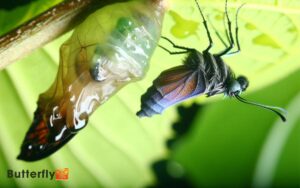Do Caterpillars Know They’re Gonna Be Butterflies? No!
No, caterpillars don’t know they’re going to become butterflies. Their metamorphosis is driven by instinctual cues and hormonal changes. Caterpillars have simple neural structures and lack the complex brain functions necessary for conscious awareness.
During metamorphosis, enzymes break down their tissues to form imaginal discs, leading to the creation of new body parts. Hormones like ecdysone regulate these transformations precisely.
The process is an evolutionary survival mechanism, ensuring the caterpillar becomes a butterfly without the need for conscious thought. If you explore further, you’ll uncover more about the complexities of their remarkable transformation.

Key Takeaways
The Life Cycle of a Caterpillar
The life cycle of a caterpillar begins when a female butterfly lays her eggs on a suitable host plant. You’ll find that these eggs are tiny, often only a millimeter in diameter.
Once they hatch, the larvae, or caterpillars, emerge. They start by consuming their eggshells, which provide essential nutrients. Afterward, they feed voraciously on the host plant’s leaves. This feeding stage, known as the larval stage, is vital for growth.
As they grow, caterpillars undergo several molts, shedding their exoskeletons to accommodate their increasing size. You can observe distinct stages called instars between molts.
Throughout this period, the caterpillar’s primary focus is to eat and store energy, preparing for the next phase of its life cycle.
The Science of Metamorphosis
Metamorphosis, a complex and fascinating process, involves the transformation of a caterpillar into a butterfly through a series of well-orchestrated biological changes. Initially, the caterpillar enters the pupal stage, forming a chrysalis.
Inside, the caterpillar’s body undergoes remarkable reorganization. Enzymes break down its tissues, creating a nutrient-rich soup.
From this, imaginal discs, specialized groups of cells, develop into the structures of an adult butterfly, including wings, legs, and antennae.
Hormonal changes, particularly involving ecdysone and juvenile hormone, regulate these transformations. The process is genetically programmed, ensuring that each stage occurs in a precise sequence.
Caterpillar Brain Structure
You need to understand that a caterpillar’s brain undergoes significant changes throughout its life cycle. Its neural development stages are vital for sensory processing abilities, which adapt as the caterpillar prepares for metamorphosis.
These morphological changes in the brain are essential for the transformation into a butterfly.
Neural Development Stages
Caterpillar brain structure undergoes significant changes during neural development, laying the groundwork for its eventual transformation into a butterfly.
You’ll observe that the brain, initially simple, starts to form complex neural networks. These changes are important for evolving from a crawling larva to a flying adult.
Key stages in neural development include the differentiation of neural cells, synaptic formation, and neural pruning.
| Stage | Description |
|---|---|
| Neural Cell Differentiation | Cells specialize into neurons and glial cells. |
| Synaptic Formation | Connections between neurons are established. |
| Neural Pruning | Unnecessary synapses are eliminated. |
Sensory Processing Abilities
Although it’s still in a larval stage, the caterpillar’s brain exhibits remarkable sensory processing abilities that are essential for its survival.
You’ll find that its brain integrates information from various sensory organs, including antennae and maxillary palps, to navigate its environment effectively.
Chemosensory receptors on these organs detect chemical cues, helping the caterpillar locate food and avoid predators. The brain’s neural circuits then process this data, enabling swift and appropriate behavioral responses.
Additionally, mechanoreceptors on its body sense touch and vibrations, further aiding in environmental interaction.
These sensory processing capabilities guarantee that the caterpillar can make informed decisions, vital for feeding and avoiding threats, thereby optimizing its chances of reaching the pupal stage successfully.
Brain Morphological Changes
During metamorphosis, the caterpillar’s brain undergoes significant morphological changes that are essential for its transformation into a butterfly.
You’ll find that neural stem cells in the caterpillar’s brain proliferate and differentiate, leading to the formation of new neural circuits.
These new circuits are vital for the sensory and motor functions required in the butterfly stage. The brain’s structure reorganizes, with some neurons undergoing programmed cell death to make room for these new neural pathways.
Additionally, the mushroom bodies, which are associated with learning and memory, expand considerably.
This complex process guarantees that the insect can adapt to its new lifestyle and environment as a butterfly. Understanding these changes emphasizes the intricate nature of metamorphosis.
Instincts Vs. Awareness
While the metamorphosis of caterpillars into butterflies is driven largely by instinct, the question of their awareness during this transformation remains a subject of scientific inquiry.
You might wonder if caterpillars possess any cognitive recognition of their impending change. Instincts are genetically encoded behaviors that don’t require conscious thought.
In contrast, awareness involves a level of cognitive processing and perception. Studies have shown that caterpillars follow instinctual cues to enter the pupal stage, but there’s no concrete evidence suggesting they’re consciously aware of their future as butterflies.
Neural structures in insects are relatively simple, and while they can process sensory information, attributing complex awareness to them may be anthropomorphic. Therefore, the debate between instinct and awareness continues.
Survival and Adaptation
You can observe how caterpillars exhibit evolutionary survival mechanisms such as camouflage and toxin production.
Their adaptive behavioral traits, like selective feeding and strategic movement, increase their chances of reaching the pupal stage.
These survival strategies are essential for their eventual transformation into butterflies.
Evolutionary Survival Mechanisms
Caterpillars exhibit a remarkable suite of evolutionary survival mechanisms that allow them to adapt to various environmental challenges, ensuring their successful transformation into butterflies.
You’ll find that these mechanisms include cryptic coloration, which helps them blend into their surroundings and avoid predators. Additionally, some caterpillars possess spines or toxic chemicals that deter predators from eating them.
Their ability to consume a wide variety of plant species enables them to thrive in diverse habitats, reducing the risk of starvation. Furthermore, caterpillars undergo multiple molts, shedding their exoskeletons to grow larger and stronger.
These adaptations collectively enhance their chances of reaching the pupal stage, where they’ll metamorphose into butterflies, continuing the cycle of survival and reproduction.
Adaptive Behavioral Traits
Many caterpillars exhibit adaptive behavioral traits that greatly enhance their survival and adaptation capabilities in their natural habitats.
You’ll notice they often mimic their surroundings to avoid predators. Some caterpillars even resemble twigs or leaves, making them nearly invisible.
Others have developed the ability to release noxious chemicals when threatened, deterring potential predators.
Additionally, certain species are nocturnal, reducing the risk of being spotted by daytime hunters. By feeding at night, they minimize exposure to birds and other daytime predators.
These behaviors aren’t random but are critical for their survival. You can appreciate how these adaptive traits are finely tuned to caterpillars’ environments, ensuring they live long enough to complete their metamorphosis into butterflies.
Do Caterpillars Feel Pain?
Although the question of whether caterpillars feel pain is complex, current scientific research suggests they likely have a rudimentary pain response.
You might wonder how researchers determine this. Studies have shown that caterpillars exhibit reflexive behaviors when exposed to harmful stimuli, such as withdrawing from a source of heat or injury.
These responses indicate a basic form of nociception, the sensory nervous system‘s process of detecting harmful stimuli.
However, it’s crucial to note that this doesn’t necessarily mean caterpillars experience pain in the same way humans do. Their nervous systems are far less complex, lacking the sophisticated brain structures associated with the emotional experience of pain.
Essentially, while caterpillars can detect and react to harmful stimuli, their experience is probably quite different from ours.
The Role of Hormones
Hormones play a pivotal role in regulating the metamorphic transformation from caterpillar to butterfly, orchestrating a complex series of physiological changes. You can think of hormones as the internal signals that guide this fascinating process.
Three main hormones are involved:
- Juvenile Hormone (JH): Maintains the caterpillar state by preventing the onset of metamorphosis.
- Ecdysone: Triggers molting and the initial stages of metamorphosis, prompting the caterpillar to shed its skin.
- Prothoracicotropic Hormone (PTTH): Stimulates the release of ecdysone, acting as a catalyst for change.
These hormones work in concert, ensuring that each stage of development occurs at the right time. Understanding these roles is essential for grasping how caterpillars evolve into butterflies.
Scientific Studies and Findings
You can explore neural development in larvae, focusing on how their brains adapt during metamorphosis.
Scientific studies also highlight the pivotal role of hormonal triggers that initiate this transformation.
Additionally, researchers have observed specific behavioral patterns within the chrysalis that suggest a complex, regulated process.
Neural Development in Larvae
Recent scientific studies have uncovered significant insights into the neural development of larvae, revealing complex processes that lay the groundwork for their eventual transformation into butterflies.
Researchers have identified three critical stages in neural development:
- Neurogenesis: The creation of new neurons, forming the basic neural architecture.
- Synaptogenesis: The formation of synapses, allowing neurons to communicate effectively.
- Neural Pruning: The refinement of neural networks, ensuring only the most efficient connections remain.
These stages are essential for the larvae’s ability to sense their environment and respond to stimuli.
Advanced imaging techniques have shown that neural circuits become increasingly specialized, preparing the larvae for their future roles as butterflies. This specialization allows the larvae to process sensory information more efficiently, ensuring a smooth transition into the complexities of adulthood. Researchers have also discovered intriguing connections between these developing circuits and the visual systems that will later help butterflies and their wing vision adapt to their environments. By the time metamorphosis is complete, these neural networks are finely tuned for tasks such as navigation, foraging, and mate selection.
Understanding these processes gives us a clearer picture of how these creatures develop such intricate neural systems.
Hormonal Triggers for Metamorphosis
Building upon the intricate neural groundwork established during larval development, the onset of metamorphosis is intricately regulated by hormonal triggers, as demonstrated by recent scientific studies.
Researchers have identified key hormones ecdysone and juvenile hormone that orchestrate this complex transformation.
Ecdysone initiates the molting process, while fluctuations in juvenile hormone levels determine the timing of the developmental stages.
Here’s a concise summary:
| Hormone | Function | Timing |
|---|---|---|
| Ecdysone | Triggers molting | Peaks before each molt |
| Juvenile Hormone | Regulates developmental progression | High in early stages, low before pupation |
| PTTH | Stimulates ecdysone release | Peaks before ecdysone surge |
| Eclosion Hormone | Finalizes metamorphosis | Released just before emergence |
These hormonal interactions ensure precise coordination, enabling the caterpillar to successfully evolve into a butterfly.
Behavioral Patterns in Chrysalis
Numerous scientific studies have meticulously documented the behavioral patterns exhibited by caterpillars during the chrysalis stage, revealing a fascinating array of activities essential for successful metamorphosis.
You’ll find that these activities aren’t random but are pivotal for the transformation process.
Researchers have identified several key behaviors:
- Reorganization of Body Structure: Cells break down and reform into various butterfly parts.
- Nutrient Utilization: Stored nutrients are redistributed to support the growth of new structures.
- Protective Mechanisms: The chrysalis often exhibits subtle movements to deter predators.
These behaviors ensure the caterpillar’s successful conversion into a butterfly. Understanding these complex processes helps you appreciate the intricate balance of nature’s metamorphosis.
Comparing Insect Consciousness
When comparing insect consciousness, it’s important to distinguish between the cognitive capacities of caterpillars and other insects, such as bees and ants, which demonstrate varying levels of awareness and decision-making.
Bees exhibit complex behaviors, including navigation, communication, and learning, indicating a higher level of cognitive function. Ants also show sophisticated social structures and problem-solving abilities.
In contrast, caterpillars primarily focus on feeding and growth, with limited evidence of advanced cognitive processes. While bees and ants may navigate and communicate effectively, caterpillars appear to operate more on instinctual routines.
Understanding these differences helps you appreciate the variability in insect consciousness and the specialized roles each species plays in their respective ecosystems.
The Mystery of Metamorphosis
While caterpillars may not exhibit the same cognitive complexities as bees or ants, their metamorphosis into butterflies presents one of nature’s most remarkable transformations.
As you observe this process, you’ll notice several fascinating stages:
- Larval Stage: The caterpillar focuses on eating and growing, shedding its skin multiple times.
- Pupal Stage: It forms a chrysalis, where its body undergoes a dramatic reorganization.
- Adult Stage: The fully formed butterfly emerges, ready to fly and reproduce.
During metamorphosis, cells called imaginal discs, present in the larva, develop into adult structures like wings and antennae. Hormones like ecdysone orchestrate these changes, ensuring each phase progresses smoothly.
This complex process remains a subject of scientific inquiry, revealing the intricate choreography of life’s transformations.
Conclusion
Just as Alice navigated Wonderland’s mysteries, caterpillars journey through metamorphosis, driven by instinct and hormones rather than conscious awareness.
Scientific studies highlight the complexity of their brain structure and behaviors, yet leave us pondering the enigma of insect consciousness.
While we can’t say caterpillars ‘know’ they’ll become butterflies, their transformation is a tribute to nature’s intricate design, where survival and adaptation reign supreme.
The enigma of their metamorphosis remains a fascinating chapter in the natural world.







Your point of view caught my eye and was very interesting. Thanks. I have a question for you.
Your article helped me a lot, is there any more related content? Thanks!
Thank you for your sharing. I am worried that I lack creative ideas. It is your article that makes me full of hope. Thank you. But, I have a question, can you help me?
Thank you for your sharing. I am worried that I lack creative ideas. It is your article that makes me full of hope. Thank you. But, I have a question, can you help me?
Your article helped me a lot, is there any more related content? Thanks!
I don’t think the title of your article matches the content lol. Just kidding, mainly because I had some doubts after reading the article.
Your article helped me a lot, is there any more related content? Thanks!
Can you be more specific about the content of your article? After reading it, I still have some doubts. Hope you can help me.
I don’t think the title of your article matches the content lol. Just kidding, mainly because I had some doubts after reading the article.